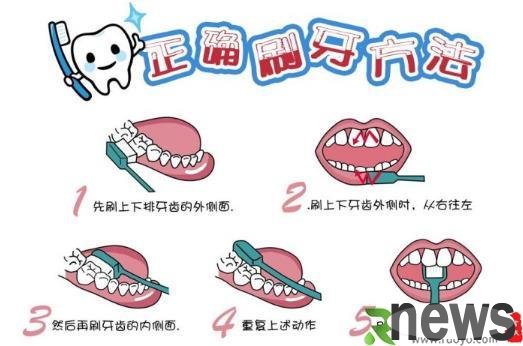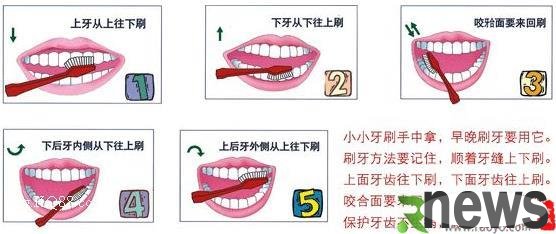
Brushing teeth is something we have to do every day. Some hygienic women even brush three times a day. So have we brushed our teeth right every day? How should I brush my teeth correctly?
How should I brush my teeth correctly?
It is not advisable to wet the toothbrush before brushing, as this may cause the toothbrush to be unclear.
Most people habitually moisten their toothbrush first and then squeeze the toothpaste when brushing their teeth. But in fact, it is not possible to brush your teeth.
If the toothbrush is wet, it will easily foam after squeezing the toothpaste. If there is too much foam in the mouth, people will feel that they have been brushing their teeth for a long time and think that it can be finished. At this time, the teeth have not been really cleaned.
Toothpaste does not use foam to clean teeth, but relies on the cleaning ingredients inside and the friction between the toothbrush and the teeth. The finer the friction and longer the time, the cleaner the brushing.
The correct way is to not dip the toothbrush in water, squeeze the toothpaste and brush it slowly, gradually produce some subtle foam, so that the cleaning ingredients of the toothpaste can be maximized.
Recommended for correct brushing methods:
Print for brushing
Sweep in zones. First, divide the entire mouth teeth into several communities (each area includes about 2 to 3 teeth); brush in sequence, in a certain order, such as up and down first, left and right first, outside and then inside, to avoid missing; brush on three sides, the lip and cheek surface, palate and tongue surface and occlusal surface (the side where the teeth chew food) must be brushed; brush repeatedly, and each community requires repeated brushing 3 to 4 times.

Brushing method:
Brushing method for the lip and cheek surface and the palate side of the posterior teeth. First, place the bristles on the lip and cheek surface and palate side of the lip and cheek surface to brush. The bristles are parallel to the long axis of the teeth. The tip of the bristles is facing the gums and close to the gums and the tooth surface. Then twist the toothbrush about 45o, and follow the interdental joints toward the occlusal surface (the upper teeth are from top to bottom, and the lower teeth are from bottom to top), use the brushing action to brush and remove dirt; if the brushing method for the tongue surface of the front teeth is square or wide, the above actions can still be used to wash. If the teeth are pointed or narrow, the tip of the toothbrush is in contact with the tongue surface and moves in an arc from the gingival edge to the incision edge; when brushing the occlusal surface, the toothbrush is pressed tightly on the occlusal surface and pulled forward and backward.

Teach you to choose a toothbrush with good health care effects
When buying a toothbrush, the first thing you need to do is to look at the size of the brush head. The brush head should generally be slightly smaller to ensure that it can rotate flexibly in the mouth. Children have a small mouth, so the brush head needs to be smaller. In general, the size of the brush head depends on each person's situation, and factors such as the size of the mouth, the degree of mouth opening and personal habits need to be comprehensively considered. There is no unified standard. ”The American Dental Association recommends that adult toothbrushes should be: the brush head is about 2.54-3.18 cm long and about 0.79-0.95 cm wide; bristles are 2-4 rows, 5-12 bundles per row. However, adults can also choose children's toothbrushes with a brush head of 2.3 cm long and 0.8 cm wide.
Secondly, it depends on the softness and hardness of the bristles. The bristles should be moderately soft or slightly soft. But be careful, too soft hair is easy to brush clean. In the past, bristles were made of pig bristles, which were very hard and could easily damage teeth and gums, and have now been basically eliminated; current bristles are mostly made of nylon silk. Specifically, it can be divided into two types - ordinary silk and DuPont silk. DuPont silk has better elasticity and is not easy to fall.
Third, hair treatment is also very important. After cutting, if the bristles are not smoothly treated, they may easily cause damage due to being too sharp. A grinding toothbrush that rounds the tip of the bristles can prevent this damage and have a stronger protective effect on gums.
At the same time, the doctor reminds everyone that it is best to replace the toothbrush every 3 months. Use it for too long, bacteria accumulate in the bristles, which is not conducive to oral health. People who use DuPont silk bristles should not change their toothbrushes because the bristles are not falling.
In addition, whether the brush head is square or diamond-shaped, the upper edge of the bristles is flush or wavy, and whether the brush handle is curved or straight has no effect on the brushing effect. It would be great to use the most common straight-handled toothbrush to brush your teeth.
